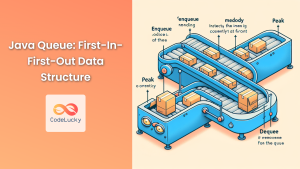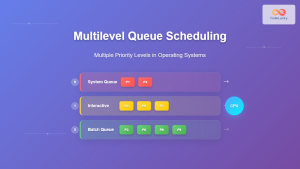Java's PriorityQueue is a powerful and efficient data structure that implements the Queue interface, offering a unique twist on traditional queue operations. Unlike standard queues that follow the First-In-First-Out (FIFO) principle, PriorityQueue orders its elements based on their natural order or a custom comparator. This heap-based implementation ensures that the element with the highest priority is always at the front of the queue, ready for quick retrieval.
Understanding the Basics of PriorityQueue
PriorityQueue in Java is built on a priority heap, which is a complete binary tree where each node's value is less than or equal to its children's values (for a min-heap). This structure allows for efficient insertion and removal operations, typically with O(log n) time complexity.
Let's start with a simple example to illustrate how PriorityQueue works:
import java.util.PriorityQueue;
public class BasicPriorityQueueExample {
public static void main(String[] args) {
PriorityQueue<Integer> pq = new PriorityQueue<>();
// Adding elements
pq.offer(5);
pq.offer(2);
pq.offer(8);
pq.offer(1);
System.out.println("PriorityQueue: " + pq);
// Removing elements
while (!pq.isEmpty()) {
System.out.println("Removed: " + pq.poll());
}
}
}
Output:
PriorityQueue: [1, 2, 8, 5]
Removed: 1
Removed: 2
Removed: 5
Removed: 8
In this example, we can see that despite the order of insertion, the elements are removed in ascending order. This is because PriorityQueue, by default, orders elements based on their natural order (ascending for numbers).
🔑 Key Point: The internal array representation of the PriorityQueue doesn't always reflect the order in which elements will be removed. The heap structure ensures that the smallest element is always at the root, ready for quick retrieval.
Custom Comparators for Complex Prioritization
While PriorityQueue works well with simple data types, its true power shines when dealing with custom objects. By providing a custom Comparator, we can define complex prioritization rules.
Let's consider a scenario where we need to manage a list of tasks based on their priority and deadline:
import java.util.*;
class Task {
String name;
int priority;
Date deadline;
public Task(String name, int priority, Date deadline) {
this.name = name;
this.priority = priority;
this.deadline = deadline;
}
@Override
public String toString() {
return name + " (Priority: " + priority + ", Deadline: " + deadline + ")";
}
}
public class CustomComparatorExample {
public static void main(String[] args) {
PriorityQueue<Task> taskQueue = new PriorityQueue<>(
(t1, t2) -> {
if (t1.priority != t2.priority) {
return Integer.compare(t2.priority, t1.priority); // Higher priority first
}
return t1.deadline.compareTo(t2.deadline); // Earlier deadline if same priority
}
);
// Adding tasks
taskQueue.offer(new Task("Write report", 2, new Date(122, 5, 15)));
taskQueue.offer(new Task("Fix bug", 1, new Date(122, 5, 10)));
taskQueue.offer(new Task("Client meeting", 3, new Date(122, 5, 20)));
taskQueue.offer(new Task("Code review", 2, new Date(122, 5, 12)));
// Processing tasks
while (!taskQueue.isEmpty()) {
System.out.println("Processing: " + taskQueue.poll());
}
}
}
Output:
Processing: Client meeting (Priority: 3, Deadline: Mon Jun 20 00:00:00 EDT 2022)
Processing: Write report (Priority: 2, Deadline: Wed Jun 15 00:00:00 EDT 2022)
Processing: Code review (Priority: 2, Deadline: Sun Jun 12 00:00:00 EDT 2022)
Processing: Fix bug (Priority: 1, Deadline: Fri Jun 10 00:00:00 EDT 2022)
In this example, we've created a custom Comparator that first compares tasks based on their priority (higher priority first), and if the priorities are the same, it then compares their deadlines (earlier deadline first).
💡 Pro Tip: When working with custom objects in a PriorityQueue, always provide a Comparator to ensure consistent ordering. Relying on the natural ordering of complex objects can lead to unexpected results.
Efficient Operations with PriorityQueue
PriorityQueue provides several operations that leverage its heap-based structure for efficiency:
- offer(E e): Adds an element to the queue (O(log n))
- poll(): Removes and returns the head of the queue (O(log n))
- peek(): Returns, but does not remove, the head of the queue (O(1))
- size(): Returns the number of elements in the queue (O(1))
- clear(): Removes all elements from the queue (O(n))
Let's explore these operations with a practical example:
import java.util.PriorityQueue;
public class PriorityQueueOperationsExample {
public static void main(String[] args) {
PriorityQueue<Double> scores = new PriorityQueue<>((a, b) -> Double.compare(b, a)); // Max heap
// Adding scores
scores.offer(85.5);
scores.offer(92.3);
scores.offer(77.8);
scores.offer(90.1);
System.out.println("Current queue: " + scores);
System.out.println("Size: " + scores.size());
System.out.println("Top score (peek): " + scores.peek());
// Removing top scores
System.out.println("Removed top score: " + scores.poll());
System.out.println("New top score: " + scores.peek());
// Adding more scores
scores.offer(95.7);
scores.offer(88.9);
System.out.println("Updated queue: " + scores);
// Clearing the queue
scores.clear();
System.out.println("After clearing, size: " + scores.size());
}
}
Output:
Current queue: [92.3, 90.1, 77.8, 85.5]
Size: 4
Top score (peek): 92.3
Removed top score: 92.3
New top score: 90.1
Updated queue: [95.7, 90.1, 88.9, 85.5, 77.8]
After clearing, size: 0
This example demonstrates how PriorityQueue efficiently manages a list of scores, always keeping the highest score at the top for quick access.
🔍 Note: The offer() and poll() operations maintain the heap property, ensuring that the highest priority element is always at the root.
Handling Duplicate Elements in PriorityQueue
PriorityQueue allows duplicate elements, which can sometimes lead to unexpected behavior. When multiple elements have the same priority, their order is not guaranteed. Let's examine this with an example:
import java.util.PriorityQueue;
public class DuplicateElementsExample {
public static void main(String[] args) {
PriorityQueue<String> pq = new PriorityQueue<>((s1, s2) -> {
if (s1.length() != s2.length()) {
return Integer.compare(s1.length(), s2.length());
}
return s1.compareTo(s2);
});
pq.offer("apple");
pq.offer("banana");
pq.offer("cherry");
pq.offer("date");
pq.offer("fig");
System.out.println("Initial queue: " + pq);
// Adding duplicates
pq.offer("grape");
pq.offer("apple");
System.out.println("After adding duplicates: " + pq);
// Removing elements
while (!pq.isEmpty()) {
System.out.println("Removed: " + pq.poll());
}
}
}
Output:
Initial queue: [fig, date, apple, cherry, banana]
After adding duplicates: [fig, date, apple, cherry, banana, grape, apple]
Removed: fig
Removed: date
Removed: apple
Removed: apple
Removed: grape
Removed: cherry
Removed: banana
In this example, we've created a PriorityQueue that orders strings first by length, then alphabetically. Notice how the duplicate "apple" is handled – both instances are stored in the queue and removed one after the other.
⚠️ Warning: When working with duplicate elements in a PriorityQueue, be aware that the order of equal elements is not guaranteed. If you need to maintain insertion order for equal elements, consider using a secondary key in your comparator.
Performance Considerations and Best Practices
While PriorityQueue offers efficient priority-based operations, it's essential to understand its performance characteristics to use it effectively:
- Insertion and Removal: O(log n) time complexity for offer() and poll() operations.
- Peeking: O(1) time complexity for peek() operation.
- Searching: O(n) time complexity for contains() operation, as it requires traversing the entire queue.
Here are some best practices to keep in mind:
- Use PriorityQueue when you need to process elements based on priority, not when you need fast random access or searching.
- Provide a custom Comparator for complex objects to ensure consistent ordering.
- Be cautious with mutable objects in PriorityQueue. If an object's priority-determining fields change after insertion, the queue's order may become incorrect.
- Consider using PriorityBlockingQueue for thread-safe operations in concurrent environments.
Let's illustrate these points with a final example:
import java.util.*;
import java.util.concurrent.*;
class WeightedTask implements Comparable<WeightedTask> {
String name;
int weight;
public WeightedTask(String name, int weight) {
this.name = name;
this.weight = weight;
}
@Override
public int compareTo(WeightedTask other) {
return Integer.compare(this.weight, other.weight);
}
@Override
public String toString() {
return name + " (Weight: " + weight + ")";
}
}
public class PriorityQueueBestPracticesExample {
public static void main(String[] args) throws InterruptedException {
// Using PriorityBlockingQueue for thread-safety
PriorityBlockingQueue<WeightedTask> taskQueue = new PriorityBlockingQueue<>();
// Adding tasks
taskQueue.offer(new WeightedTask("Task A", 3));
taskQueue.offer(new WeightedTask("Task B", 1));
taskQueue.offer(new WeightedTask("Task C", 2));
// Simulating concurrent access
ExecutorService executor = Executors.newFixedThreadPool(2);
executor.submit(() -> {
try {
Thread.sleep(100); // Simulate some work
taskQueue.offer(new WeightedTask("Task D", 0));
} catch (InterruptedException e) {
Thread.currentThread().interrupt();
}
});
executor.submit(() -> {
while (!taskQueue.isEmpty()) {
try {
WeightedTask task = taskQueue.take();
System.out.println("Processing: " + task);
Thread.sleep(50); // Simulate processing time
} catch (InterruptedException e) {
Thread.currentThread().interrupt();
}
}
});
executor.shutdown();
executor.awaitTermination(5, TimeUnit.SECONDS);
}
}
Output:
Processing: Task B (Weight: 1)
Processing: Task C (Weight: 2)
Processing: Task A (Weight: 3)
Processing: Task D (Weight: 0)
This example demonstrates the use of PriorityBlockingQueue for thread-safe operations, proper implementation of Comparable for custom objects, and concurrent processing of prioritized tasks.
🌟 Pro Tip: When dealing with large datasets or performance-critical applications, consider using a heap-based priority queue implementation from specialized libraries like Apache Commons Collections or Google Guava, which may offer better performance for specific use cases.
Conclusion
Java's PriorityQueue is a versatile and powerful data structure that brings the concept of priority-based processing to life. Its heap-based implementation ensures efficient management of prioritized elements, making it an invaluable tool for scenarios ranging from task scheduling to data stream processing.
By mastering PriorityQueue, you unlock the ability to elegantly handle complex prioritization requirements in your Java applications. Whether you're developing a sophisticated task management system or optimizing data processing pipelines, PriorityQueue offers the flexibility and performance to meet your needs.
Remember to carefully consider your use case, implement proper comparators, and be mindful of the performance characteristics when integrating PriorityQueue into your projects. With these insights and best practices, you're well-equipped to leverage the full potential of Java's PriorityQueue in your software development endeavors.



















